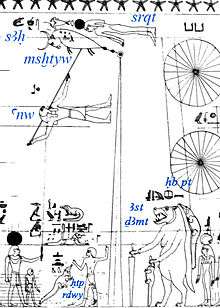Astronomical ceiling of Senemut Tomb

Astronomical ceiling decoration in its earliest form can be traced to the Tomb of Senemut (Theban tomb no. 353), located at the site of Deir el-Bahri, Egypt. The tomb and the ceiling decorations date back to the 18th Dynasty of ancient Egypt (ca. 1473 B.C.).
Discovery
The tomb of Senemut was discovered during the 1925-1927 excavations directed by Herbert Winlock for the Egyptian Expedition of the Metropolitan Museum of Art.[2]
The unearthing of the 10x12 ft. chamber yielded the two panels of what is now referred to as the Egyptian Celestial Diagram.[3]
Celestial Diagram
The Celestial Diagram consisted of a northern and a southern panel which depicted circumpolar constellations in the form of discs; each divided into 24 sections suggesting a 24-hour time period, lunar cycles, and sacred deities of Egypt. Of the constellations present on the diagram, the only certainly identifiable was Meskhetyu with the Big Dipper because of the difficulty that arises when an attempt is made to match modern day constellations with the depictions made thousands of years ago by the ancient Egyptians.[4]
- Some of the main figures and stars seen in the diagram are Sirius, Orion, Ursa Major, Draco (may be depicted as hippopotamus with crocodile on its back),
- The four circles on the top right refer to the four months of Akhet (inundation) between July and October
- The two circles at the top left and the two below them refer to the season of Peret (planting season) between November and February
- The four circles on the right refer to the season of Shomu (harvesting season) between March and June
The map on the southern panel could well reflect a specific conjunction of planets in 1534 BCE around the longitude of Sirius. The four planets Jupiter, Saturn, Mercury and Venus are relatively easily recognizable. The planet Mars is not included in the actual grouping and at first sight seems to be missing in the map. However, one explanation is that Mars is represented in the Senenmut map as an empty boat in the west. This may refer to the fact that Mars was retrograde and was not with the other planets (indeed, being in the west in the 1534 BCE conjunction). The reason for the boat being empty is perhaps in this backward movement (a well known phenomenon to the Egyptians) the position of Mars was not considered to be ”concrete”.[5]
An alternative explanation for the missing Mars is proposed by Belmonte,
″...the astronomical ceiling of the tomb of Senenmut is a gigantic copy of a papyrus draft of a celestial diagram that would have existed and used to be represented in clepsydrae (water clocks, as that of Karnak). Because of the lack of space, when moving the design from a conical to a flat surface, part of the decoration was lost.″[6]
Significance

Although the tomb had been unfinished and had sustained damage throughout the centuries, the ceiling yielded new information about astronomy, chronology, mythology, and religion in Egypt because of the incorporation of all these elements as a means of connecting the divine to the mortal world.
Egyptian astronomy consisted of the identification of the heavenly bodies in the sky and their connection with the deities that were believed to play a role in religious mythology and practice.[7]
Astronomical ceilings bore significant symbolism for the Egyptians as they combined divine religion with more earthly aspects of daily life such as agriculture and labor. The detailed depiction of astronomy and deities illustrates the Egyptians desire to understand the heavens and the attempt to apply that understanding to the gods that they believed influenced all aspects of life.
The assimilation of these elements insured that the Egyptian calendar would differ from the ancient calendars of the Sumerians and the Babylonians. Otto Neugebauer suggests that the complexity of Egyptian calendars:
- "represents the peaceful coexistence of different methods of defining time moments and time intervals in different ways on different occasions."[8]
The use of astronomical calendars was not limited to ceiling tombs as they appeared on coffin boards, water boards, temples, and various other surfaces and objects.[4]
External links
- UNESCO "ICOMOS-IAU case study: The Tomb of Senenmut at Western Thebes, Egypt includes map, documents and case study
- Metropolitan Museum has a full scan of the ceiling
Notes and references
- ↑ Full version at Met Museum
- ↑ Isis, Vol. 14, No. 2 (Oct., 1930), pp. 301-325
- ↑ Journal of the American Research Center in Egypt, Vol. 34, (1997), pp. 143-161
- 1 2 Clagett, Marshall. Ancient Egyptian Science. Vol. 2. Philadelphia: American Philos. Soc., 1995. Print.
- ↑ Novakovic, Bojan. Publications of the Astronomical Observatory of Belgrade, vol. 85, p. 19-23. http://publications.aob.rs/85/pdf/019-023.pdf
- ↑ J.A. Belmonte, and M. Shaltout, The astronomical ceiling of Senenmut: a dream of mystery and imagination, in ″Lights and shadows in cultural astronomy″ : proceedings of the SEAC 2005: Isili, Sardinia, 28 June to 3 July, edited by Mauro Peppino Zedda and Juan Antonio Belmonte. Published by Associazione Archeofila Sarda, Isili, Italy, 2007., 145-154.
- ↑ The Metropolitan Museum of Art Bulletin, Vol. 18, No. 12, Part 1 (Nov. 1923), pp. 283-286
- ↑ Current Anthropology Vol. 14, No. 4 (Oct. 1973), pp. 389-449
